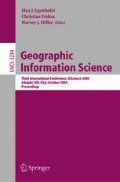Abstract
This paper discusses the construction of a modeling approach for dynamic geospatial domains based on the concepts of object and event. The paper shows how such a model extends traditional object-based geospatial models. The focus of the research is the introduction of events into the object-based paradigm, and consequent work on the classification of object-event and event-event relationships. The specific geospatial nature of this model is captured in the concept of a geosetting. The paper also introduces an extension of UML diagrams to incorporate events and their relationship to each other, and to objects. The paper briefly considers an example to show the working of some of the modeling constructs, and concludes with a discussion of further research needed on event aggregation and event-based query languages.
Access this chapter
Tax calculation will be finalised at checkout
Purchases are for personal use only
Preview
Unable to display preview. Download preview PDF.
References
Guarino, N.: Formal ontology and information systems. In: Guarino, N. (ed.) Formal Ontology in Information Systems, Proceedings of FOIS 1998, pp. 3–17. IOS Press, Amsterdam (1998)
Chrisman, N.: Beyond the snapshot: changing the approach to change, error, and process. In: Egenhofer, M.J., Golledge, R.G. (eds.) Spatial and Temporal Reasoning in Geographic Information Systems. Spatial Information Systems, pp. 85–93. Oxford University Press, New York (1998)
Booch, G., Rumbaugh, J., Jacobson, I.: The Unified Modeling Language User Guide. Addison-Wesley Longman, Amsterdam (1999)
Worboys, M.F.: Event-oriented approaches to geographic phenomena. Accepted for publication in International Journal of Geographic Information Systems (2004)
Hobbs, J.: A DAML Ontology of Time (2002), http://www.cs.rochester.edu/~ferguson/daml/daml-timenov2002
Pan, F., Hobbs, J.R.: Time in OWL-S. In: Proceedings of AAAI 2004, pp. 29–36 (2004)
Worboys, M.F.: Geographic Information Systems: A Computing Perspective. Taylor & Francis, London (1995)
Allen, J.: Maintaining knowledge about temporal intervals. Communications of the ACM 26(11), 832–843 (1983)
Snodgrass, R. (ed.): The TSQL2 Temporal Query Language. Kluwer Academic Publishers, Dordrecht (1995)
Snodgrass, R.: Developing time-oriented database applications in SQL. Morgan Kaufmann Publishers, San Francisco (2000)
Partsinevelos, P., Stefanidis, A., Agouris, P.: Automated Spatiotemporal Scaling for Video Generalization. In: IEEE International Conference on Image Processing (ICIP), Thessaloniki, Greece, vol. 1, pp. 177–180 (2001)
Griffiths, T., Fernandes, A., Paton, N., Jeong, S.-H., Djafri, N., Mason, K.T., Huang, B., Worboys, M.: TRIPOD: A Spatio-Historical Object Database System. In: Ladner, R., Shaw, K., Abdelguerfi, L. (eds.) Mining Spatio-Temporal Information Systems, pp. 127–146. Kluwer Academic Publishers, Amsterdam (2002)
Galton, A.: Fields and objects in space, time, and space-time. Journal of Spatial Cognition and Computation 4(1), 39–68 (2004)
Hornsby, K., Egenhofer, M.: Modeling moving objects over multiple granularities, Special issue on Spatial and Temporal Granularity. Annals of Mathematics and Artificial Intelligence 36, 177–194 (2002)
Simons, P.M.: Parts. A Study in Ontology. Clarendon, Oxford (1987)
Egenhofer, M.J., Franzosa, R.D.: Point-set topological spatial relations. International Journal of Geographical Information Systems 5(2), 161–174 (1991)
Cui, Z., Cohn, A.G., Randell, D.A.: Qualitative and topological relationships in spatial databases. In: Abel, D.J., Ooi, B.-C. (eds.) SSD 1993. LNCS, vol. 692, pp. 296–315. Springer, Heidelberg (1993)
Hornsby, K., Egenhofer, M., Hayes, P.: Modeling cyclic change. In: Chen, P., Embley, D., Kouloumdjian, J., Liddle, S., Roddick, J. (eds.) Advances in Conceptual Modeling, ER 1999 Workshop on Evolution and Change in Data Management, Paris, France, pp. 98–109 (1999)
Egenhofer, M., Frank, A.: Object-Oriented Modeling for GIS. Journal of the Urban and Regional Information Systems Association 4(2), 3–19 (1992)
Worboys, M.F., Hearnshaw, H.M., Maguire, D.J.: Object-oriented data modelling for spatial databases. International Journal of Geographical Information Systems 4(4), 369–383 (1990)
Tomlin, D.: Geographic Information Systems and Cartographic Modelling. Prentice-Hall, New Jersey (1990)
Al-Taha, K., Barrera, R.: Identities through time. In: Ehlers, M., Steiner, D. (eds.) International Workshop on Requirements for Integrated Geographic Information Systems, New Orleans, LA, pp. 1–12 (1994)
Worboys, M.F.: A Unified Model of Spatial and Temporal Information. Computer Journal 37(1), 26–34 (1994)
Claramunt, C., Thériault, M.: Toward semantics for modelling spatio-temporal processes within GIS. In: Kraak, M.J., Molenaar, M. (eds.) 7th International Symposium on Spatial Data Handling, Delft, NL, pp. 47–63 (1996)
Medak, D.: Lifestyles - an algebraic approach to change in identity. In: Böhlen, M.H., Jensen, C.S., Scholl, M.O. (eds.) STDBM 1999. LNCS, vol. 1678, pp. 19–38. Springer, Heidelberg (1999)
Hornsby, K., Egenhofer, M.: Identity-based change: a foundation for spatiotemporal knowledge representation. International Journal of Geographical Information Science 14(3), 207–224 (2000)
Casati, R., Varzi, A.C.: Parts and Places: Structures in Spatial Representation. MIT Press/Bradford Books, Cambridge, MA (1999)
Grenon, P., Smith, B.: SNAP and SPAN: Towards dynamic spatial ontology. Journal of Spatial Cognition and Computation 4(1), 69–103 (2004)
Bédard, Y.: Visual modeling of spatial databases: towards spatial PVL and UML. Geomatica 53(2), 169–186 (1999)
Author information
Authors and Affiliations
Editor information
Editors and Affiliations
Rights and permissions
Copyright information
© 2004 Springer-Verlag Berlin Heidelberg
About this paper
Cite this paper
Worboys, M., Hornsby, K. (2004). From Objects to Events: GEM, the Geospatial Event Model. In: Egenhofer, M.J., Freksa, C., Miller, H.J. (eds) Geographic Information Science. GIScience 2004. Lecture Notes in Computer Science, vol 3234. Springer, Berlin, Heidelberg. https://doi.org/10.1007/978-3-540-30231-5_22
Download citation
DOI: https://doi.org/10.1007/978-3-540-30231-5_22
Publisher Name: Springer, Berlin, Heidelberg
Print ISBN: 978-3-540-23558-3
Online ISBN: 978-3-540-30231-5
eBook Packages: Springer Book Archive

